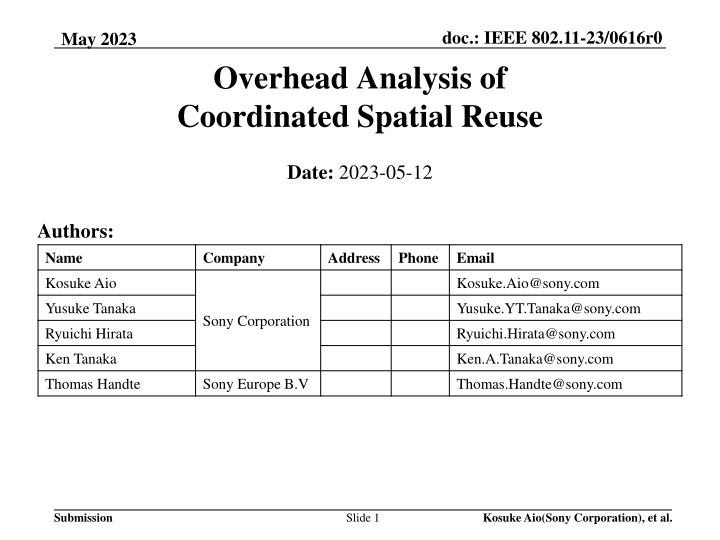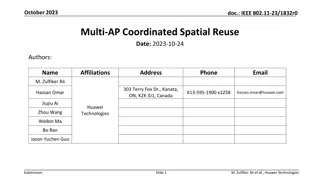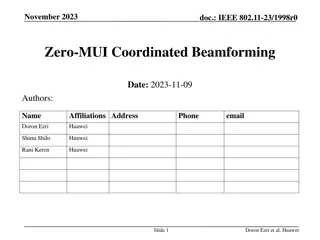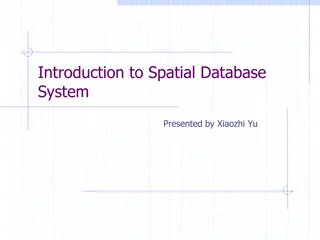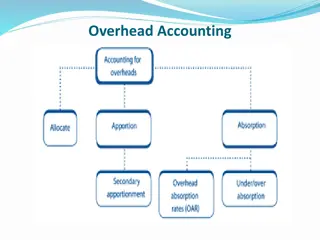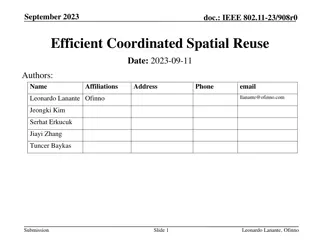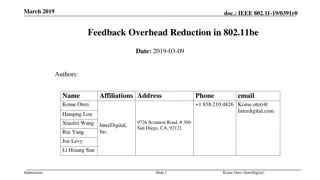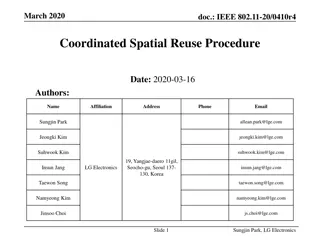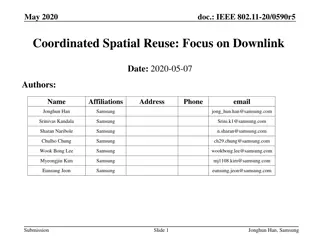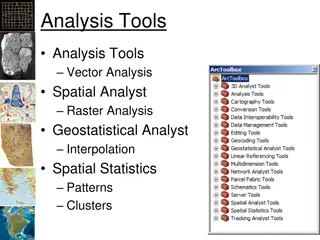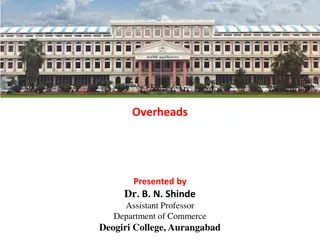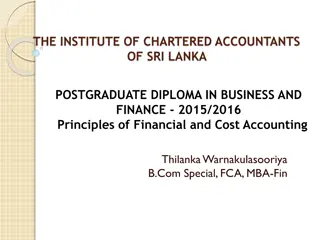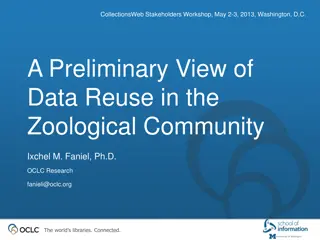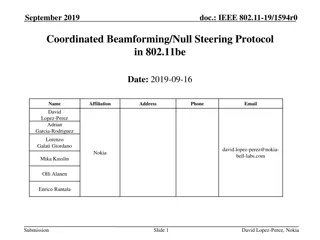Overhead Analysis of Coordinated Spatial Reuse in IEEE 802.11-23
Analysis of overhead components impacting the performance of Coordinated Spatial Reuse (Co-SR) in IEEE 802.11-23 standard for wireless communication. Evaluation of MAC overhead, negotiation and measurement phases, and frames in the negotiation phase. Discussion on the impact of overhead on Co-SR performance and estimation of negotiation phase duration. Insights into multi-AP coordination for enhanced wireless throughput in next-generation technology.
Download Presentation

Please find below an Image/Link to download the presentation.
The content on the website is provided AS IS for your information and personal use only. It may not be sold, licensed, or shared on other websites without obtaining consent from the author.If you encounter any issues during the download, it is possible that the publisher has removed the file from their server.
You are allowed to download the files provided on this website for personal or commercial use, subject to the condition that they are used lawfully. All files are the property of their respective owners.
The content on the website is provided AS IS for your information and personal use only. It may not be sold, licensed, or shared on other websites without obtaining consent from the author.
E N D
Presentation Transcript
doc.: IEEE 802.11-23/0616r0 May 2023 Overhead Analysis of Coordinated Spatial Reuse Date: 2023-05-12 Authors: Name Company Address Phone Email Kosuke Aio Kosuke.Aio@sony.com Yusuke Tanaka Yusuke.YT.Tanaka@sony.com Sony Corporation Ryuichi Hirata Ryuichi.Hirata@sony.com Ken Tanaka Ken.A.Tanaka@sony.com Thomas Handte Sony Europe B.V Thomas.Handte@sony.com Submission Kosuke Aio(Sony Corporation), et al. Slide 1
doc.: IEEE 802.11-23/0616r0 May 2023 Introduction Multi-AP coordination is a candidate feature for next TG (TGbn) as a technology to realize the several objectives and use cases of UHR [1]. Performance of Coordinated Spatial Reuse (Co-SR) was evaluated [2], and it was shown that Co-SR can achieve higher throughput gain compared to TDD and 11ax/OBSS-PD. Sharing AP only need RSSI information of interference link and estimate SINR of STA(s) which The sharing AP intends to serve to. The performance was without MAC and PHY preamble overhead. This contribution analyzes how much the overhead affects the performance of Co-SR. Submission Kosuke Aio(Sony Corporation), et al. Slide 2
doc.: IEEE 802.11-23/0616r0 May 2023 Components of Overhead There are two MAC overhead components that would affect performance of Co-SR. 1. Negotiation phase Sharing AP need to collect information from Candidate APs and trigger Shared APs to transmit data before coordinated transmission. 2. Measurement phase All APs need to collect RSSI information of interference Here, we assume only wireless link between APs. AP1 s TXOP AP2 s TXOP Negotiation Phase Negotiation Phase DATA Tx DATA Tx AP1 Measurement Phase DATA Tx DATA Tx AP2 DATA Tx DATA Tx AP3 time Submission Kosuke Aio(Sony Corporation), et al. Slide 3
doc.: IEEE 802.11-23/0616r0 May 2023 Overhead Analysis of Negotiation Phase (1/4) Consideration on new frames (name is TBD) Coordination Request frame (Sharing AP -> Candidate APs) To collect information about STAs which potential they intend to transmit data to. The existing Trigger frame could be used. Coordination Response frame (Candidate APs -> Sharing AP) Coordination Trigger frame (Sharing AP -> Shared APs The existing Trigger frame could be used. Need to add Tx Power value of Sharing AP in Trigger Dependent Common Info (+ 1byte) Need to add Tx Power value of Shared AP in Trigger Dependent User Info (+ 1byte) Negotiation Phase Coordination Trigger Coordination Request DATA Tx AP1 DATA Tx AP2 Coordination Response DATA Tx time AP3 Submission Kosuke Aio(Sony Corporation), et al. Slide 4
doc.: IEEE 802.11-23/0616r0 May 2023 Overhead Analysis of Negotiation Phase (2/4) Estimation of negotiation phase duration Frame size estimation [unit: byte] Coordination request: 30 + 5 * Ncap (Candidate APs) Coordination response: 18 + 3 * Nsta (STAs in a BSS) Coordination trigger: 31 + 6 * Nsap (Shared APs) When the above frames are sent in HT/MCS0/20MHz, estimated time of negotiation phase are in the following table. Totally around 300us. Here, assuming Candidate APs = Shared APs. Ncap (Nsap) = Nap - 1 Including SIFS and preamble for each frame. Nsta = 1 272 us 288 us 300 us Nsta = 2 276 us 292 us 304 us Nsta = 3 280 us 296 us 308 us Nsta = 4 284 us 300 us 312 us Nap = 2 Nap = 3 Nap = 4 Submission Kosuke Aio(Sony Corporation), et al. Slide 5
doc.: IEEE 802.11-23/0616r0 May 2023 Overhead Analysis of Negotiation Phase (3/4) For the simulation conditions presented in [2], Nap = 3 and Nsta = 1. Therefore, the Negotiation Phase takes 288us. When PPDU ( Data Tx in slide.3) duration is assumed to be 4ms, overhead ratio is around 7.2%. The following graph shows Co-SR performance with the overhead. Despite of the overhead, we can confirm Co-SR can achieve high throughput gain. Throughput at 95%-tile Same Scenario in [2] CDF of Throughput in d = 10m d [m] d [m] d [m] d [m] Submission Kosuke Aio(Sony Corporation), et al. Slide 6
doc.: IEEE 802.11-23/0616r0 May 2023 Overhead Analysis of Negotiation Phase (4/4) Consideration of the overhead analysis of the negotiation phase Frame exchange takes a certain amount of time (around 300us) but does not have much impact on Co-SR performance in the previous scenario. However, we should take care of the overhead in the following case: Short data duration Due to very high data rate, low traffic, low maximum aggregation numbers. The overhead ratio increases and has much impact on the throughput. Low latency transmission. The time of negation phase will worsen the access delay. To improve the above cases, we can discuss the following points. Ways to decrease the number and size of frames. Use higher MCS for negotiation frames. Unsynchronized coordination case as the 11ax SR enhancement [3]. Submission Kosuke Aio(Sony Corporation), et al. Slide 7
doc.: IEEE 802.11-23/0616r0 May 2023 Overhead Analysis of Measurement Phase (1/4) Consideration Points for Measurement Phase Overhead 1. How much time is occupied for the measurement? The phase in which STA measures RSSI of signal (such as Beacon ) from other APs can be carried out in parallel with the service, so the basic overhead is negligible (but the measurement completion time may be prolonged). Measurement Request/Response between AP and STAs should be considered. (detail in next slide.) 2. How often do measurements have to be taken? It depends on the Doppler frequency. I assumed two types of channel (non mobility and mobility) and estimated the appropriate measurement interval (details on slide.10) Submission Kosuke Aio(Sony Corporation), et al. Slide 8
doc.: IEEE 802.11-23/0616r0 May 2023 Overhead Analysis of Measurement Phase (2/4) We can use the existing Beacon Measurement schemes. Estimation of measurement phase time Frame size estimation [unit: byte] Measurement request (broadcast): 18 Trigger frame (to solicit responses in UL OFDMA) : 30 + 5 * Nsta (STAs in a BSS) Measurement response: 31 * Ncap (Candidate APs) When the above frames are sent in MCS0/20MHz and UL OFDMA up to 4 STAs, estimated time of the measurement phase are in the following table. Ncap = Nap - 1 Including SIFS and preamble of each frame. Measurement Requests/Reponses are exchanged in each BSS. Nsta = 1 496 us 864 us 1,296 us Nsta = 2 512 us 888 us 1,328 us Nsta = 3 520 us 900 us 1,344 us Nsta = 4 536 us 924 us 1, 376 us Nap = 2 Nap = 3 Nap = 4 Submission Kosuke Aio(Sony Corporation), et al. Slide 9
doc.: IEEE 802.11-23/0616r0 May 2023 Overhead Analysis of Measurement Phase (3/4) Estimation of measurement interval Non-mobility case: 11ac/Channel Model D [4] Assume that AP/STA don t move and people walking around it, but environment changes slowly. Doppler freq. = 0.414Hz and coherence time = 800ms (approximately) Mobility case: Assume that AP doesn t move, and STAs move at walking speed [5] Doppler freq. = 5.0Hz and coherence time = 66ms (approximately) Within the above coherence time, the channel is considered as static. That means it will be OK that measurement interval is set to at least the coherence time. That implies the overhead of the measurement phase won't have that big an impact for both non mobility and mobility cases. Submission Kosuke Aio(Sony Corporation), et al. Slide 10
doc.: IEEE 802.11-23/0616r0 May 2023 Overhead Analysis of Measurement Phase (4/4) Summary of overhead analysis of measurement phase In terms of the overhead, the performance impact of exchanging the frames for measurement would not be significant. However, in the mobility case, Beacon measurements may not be able to follow RSSI changes. Normally, Beacon interval is 100 - 200ms. If it takes more time as the coherence time (66ms) from the start to the end of the measurement, there is a high possibility that RSSI will have varied significantly at the coordinated transmission. To improve the above cases, we can discuss the ways to collect RSSI information between STA and OBSS AP in short time. Submission Kosuke Aio(Sony Corporation), et al. Slide 11
doc.: IEEE 802.11-23/0616r0 May 2023 Summary We analyzed two types of MAC overhead: negotiation phase and measurement phase. In terms of throughput improvement, the proposal of Co-SR protocol was found to be superior to the existing system, even taking into account the overhead caused by the two phases. At the same time, there are some future discussion points: Ways to decrease the number/duration of frames in the negation phase. Unsynchronized coordination case as the 11ax SR enhancement. Ways to collect RSSI information between STA and OBSS AP in short time for mobility case. Submission Kosuke Aio(Sony Corporation), et al. Slide 12
doc.: IEEE 802.11-23/0616r0 May 2023 Reference [1] Yusuke Tanaka (Sony Group Corporation), Considerations on Multi-AP Coordination, 22/1516r0, September 2022. [2] Kosuke Aio (Sony Group Corporation), Recap on Coordinated Spatial Reuse Operation, 22/1822r0, November 2023. [3] Rui Yang (InterDigital), Spatial Reuse in Coordinated M-AP for UHR, 23/0058r0, February 2023 [4] Greg Breit (Qualcomm), TGac Channel Model Addendum Document, 09/0308r12, March 2010 [5] Shimi Shilo (Huawei), Adapting the 11be channel model to modern (Doppler) use cases, 19/1579r3, January 2020 Submission Kosuke Aio(Sony Corporation), et al. Slide 13
doc.: IEEE 802.11-23/0616r0 May 2023 Appendix 11ax Channel Analysis Doppler freq. = 5.5Hz (11n Channel Model) Average channel gain power over 20MHz seems to be constant in 200ms, but if smaller RUs (e.g. RU26, 52) and/or MIMO are also applied in Co-SR, coherence time needs to be paid attention. Submission Kosuke Aio(Sony Corporation), et al. Slide 14
